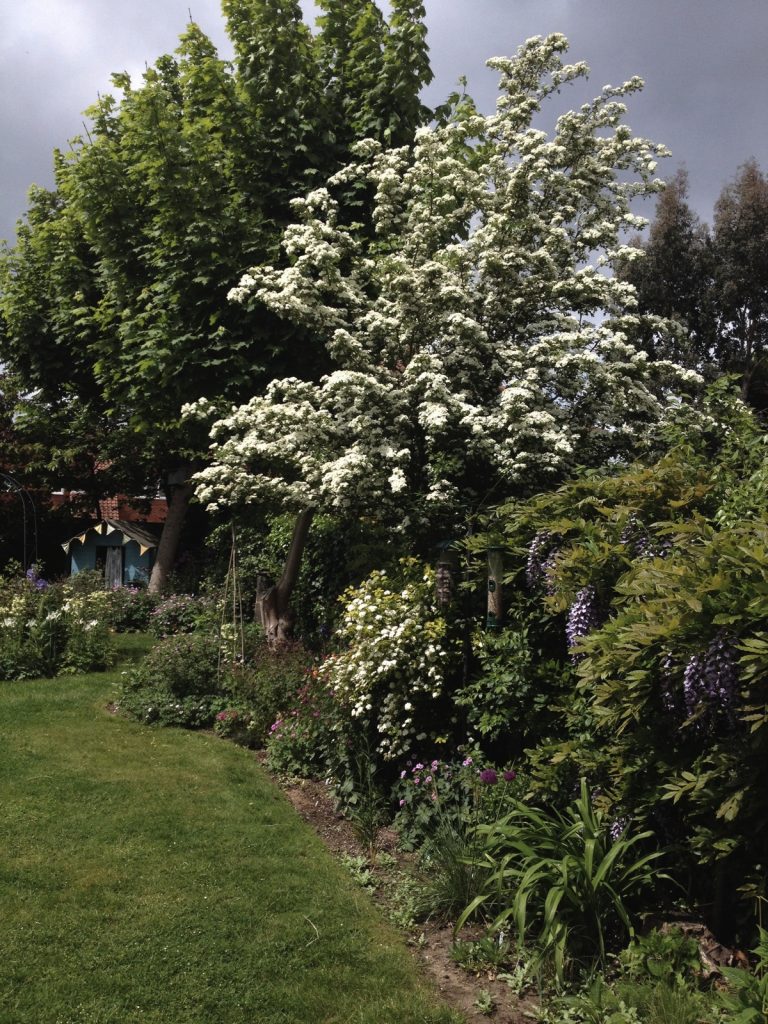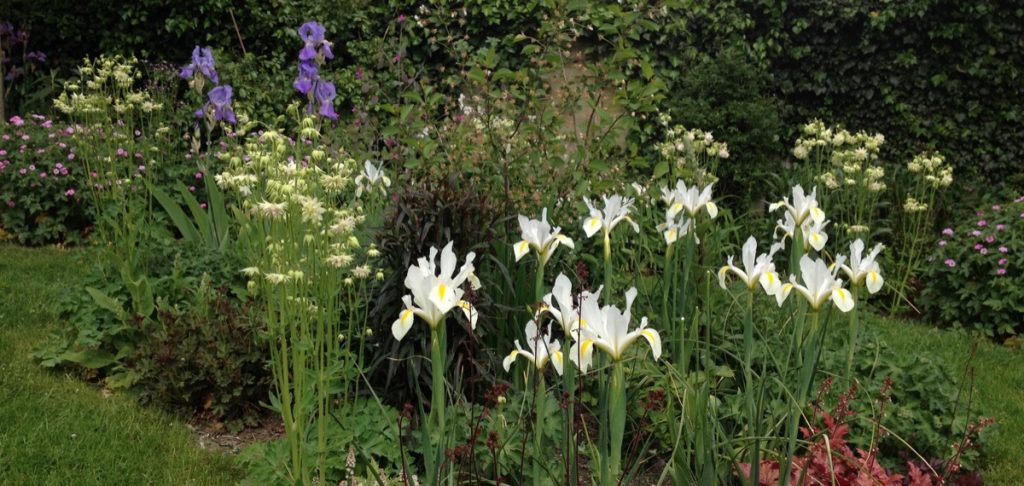
In my garden this month, the tulips have made way for the irises. Bearded iris flowers provide fat brushstrokes of colour that tower over the borders on tall stems. The smaller flowers of siberian and dutch irises are just as rich in colour, with contrasting throat markings and an intricate petal shape. They are exquisite.
Aquilegia (also known as granny’s bonnet) are also flowering now, high up on more delicate stems, with starry blooms in whites and purples. They create a kind of regular punctuation that runs through all the sunny borders, and unifies them.
Our hawthorn tree has never flowered like it has this year. Its branches are completely covered in white blossom this month. Did you know its folk name is May? The spiraea (The Bride) that’s growing beneath it is also in full bloom. These two together look beautiful combined with the purple flowers of the biennial honesty that I sowed and planted out last year.
Pretty bunches of purple wisteria flowers hang down beneath lush green, pinate leaves. It’s an old plant that had been languishing on the ground for years when we moved in, and I trained it on to the south-facing fence. Its flowers inject early interest into my new prairie border, which won’t be much to look at until mid-summer.
From now until late-summer, wave after wave of flowers will follow as each one recedes, like movements in a symphony of shape and colour. It will build up to a dramatic crescendo in July, and then slowly die down, until late October, when most flowers will have faded away. More and more flowers are opening, gaps in the herbaceous borders are disappearing, and there are promising buds forming on so many plants. Foxgloves are sending up compact spires of buds that will extend and open in succession from the bottom to the top of the stem. Floribunda roses are forming dense groups of green buds with starry sepals. And the hydrangeas have clusters of tightly packed pinheads that are going to become great big, blousy, floral delights in a few weeks.
I love May. It’s the month when all my hard work in the spring starts to pay off. There are flowers opening everywhere, and I finally have time to sit and enjoy them without feeling like there are a million jobs still to do. There is still lots of gardening to do, of course, but the sense of urgency that I felt in March and April has eased off. I can slow down now and just let the plants do their thing.
Here are some things that you can be doing for your garden this month:
Fill Your Garden With Flowers Every Week
If you find there are times over the summer when there are no flowers in your garden, then go out and buy some new flowering plants that will fill that gap. This is my list of essential, easy-to-grow plants that will ensure you have stunning flowers (roughly in order of flowering) from May to September: irises, foxgloves, roses, lilies, hydrangeas, and asters. These plants will take turns to be the stars of your garden while they are in flower, and if you grow all of them, somewhere in your garden, you will have flowers all summer.
Watch Or Visit The Chelsea Flower Show
It’s the RHS Chelsea Flower Show this week. If you can’t go to the show, there will be lots of coverage of the show on television, and watching it is a fantastic way to get some inspiration for your own garden. Okay, you won’t be able to faithfully recreate a Chelsea show garden at home (unless you have a quarter of a million pounds to spend on your garden). But you can definitely take away some good design ideas, from hard landscaping or garden structures, to planting combinations and new plant varieties. I’m heading down to Chelsea with my mum and sister on Wednesday this week. It’s my first year visiting the show, and I’m very excited! I’ll take lots of photos and will undoubtedly write a post about it when I get back.
Battle The Slugs & Snails
I heard Bob Flowerdew say on Gardener’s Question Time last week that this is a bad year for slugs and snails, and I have to agree with him. It’s probably the mild winter that was to blame. Is it just us Norfolk gardeners who are suffering, or are you too? They have munched the new tips of my summer flowering bulbs – liatris seems to be particularly tasty – and my dahlias have also taken a hit. I don’t usually do much to reduce slug and snail numbers in my garden, I’m more of a live-and-let-live gardener, hoping that a good wildlife balance will take care of most pest problems. But this year I might well be out in the evenings, with my gloves and a bucket of water and dish soap, murdering them. I’ve already stamped on three snails this week! In the past I’ve always chucked them into the middle of the lawn and left them to take their chances with the birds. My killer instinct is clearly growing. Molluscs of Norwich, beware…







